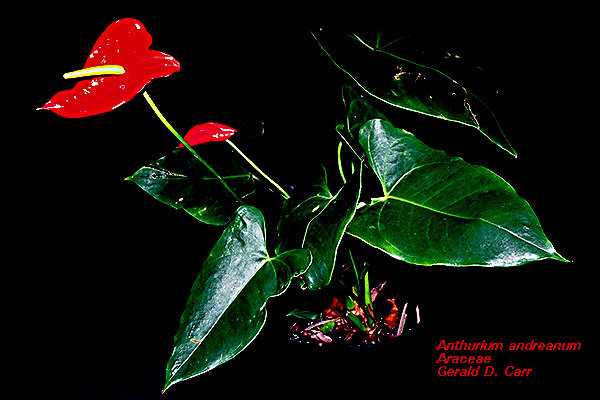|
Spathiphyllum x clevelandii. Note the expanded petaloid bract or
spathe subtending the fleshy spike or spadix packed with minute flowers. In the top right
photo is a surface view of the spadix. The perianth segments can be seen around the base
of each ovary. These are bisexual flowers. The tips of a few anthers can be seen opposite
the tepals. Each pistil has 3 sessile stigma lobes, suggesting the 3-carpellate nature of
the gynoecium. The lower right photo is a cross-sectional view of the spadix revealing
stamens at 3 and 7 o'clock and 2 of the locules in each of the ovaries at 8:30, 10:30 and
1:30. The perianth is partly visible and is pressed against the base of the ovaries in the
upper left area of the photo. |
|
Dieffenbachia picta, dumb cane. The common name refers to the
loss of voice that commonly occurs when any part of this plant is ingested. Note the white
spadix and green spathe to the left of the spadix. The lower photo shows a single calcium
oxalate crystal (raphide). Great numbers of these are released from storage
"packets" into the plant sap when any part of the plant is damaged. They cause
severe itching if the sap contacts the skin. If ingested, the mucous membranes are
irritated. This can cause temporary loss of voice or reportedly in small children death
may result. |
 |
Xanthosoma sp. In this view the spathe has been partly cut away
to reveal the flowers on the spadix. Note a few droplets of milky sap. In Araceae that
have imperfect flowers, the plants are generally monoecious. Female flowers, in this case
yellow, are typically located at the base of the spadix. Above these are male flowers,
pink and white in this case. Sometimes the upper part of the spadix is sterile. |
 |
Pistia stratiotes, water lettuce. This unusual aquatic member of
the family floats on the surface of ponds or streams. The swollen leaf bases have airy
tissue and act as buoys to keep the plants afloat. Though small, the spathe and spadix
nature of the inflorescence in this species is still rather typical. The upper part of the
spadix has 2-8 staminate flowers and the lower part bears a single pistillate flower. A
portion of a sectioned leaf with its buoyant tissue can be seen at the lower right. |
|
Monstera deliciosa, monstera. A spreading or climbing ornamental
plant from Central America, with large, naturally perforated (fenestrated) leaves. The
fruit is considered tasty by some, and has been said to combine the flavors of bananas and
pineapples. |
 |
Anthurium andreanum, anthurium. Small, herbaceous plant from
tropical America, grown for the long-lasting flowers (and associated bracts), which are
very popular in floral arrangements. A significant commercial crop, especially of the
island of Hawaii. |
 |
Caladium sp., caladium. Ornamental species grown mainly for the
colorful foliage. |
 |
Colocasia esculenta, taro, kalo. Herbaceous plant from old world
tropics, with thick tuber (underground stem)containing much starch; cultivated for food
for many centuries. Taro was brought to Hawaii by early migrating Polynesians as the main
food source. They had perhaps 300 varieties taro under cultivation at one time. The leaves
of many varieties were also eaten. Taro must be cooked to destroy the acrid crystals of
calcium oxalate found in all parts of the plant. Taro was so important that it had great
influence on the social and individual activities of the community. One obvious
ramification of taro cultivation involved water utilization. Such was the importance of
taro that it was considered the plant form (kino-lau)of the great god Kane, the giver of
life. |
|
Spathicarpa sagittifolia. In this unusual example of the family,
the spathe and spadix are adnate and the male and female flowers are intermixed along the
axis. The male flowers are the tall ones with monadelphous stamens. |